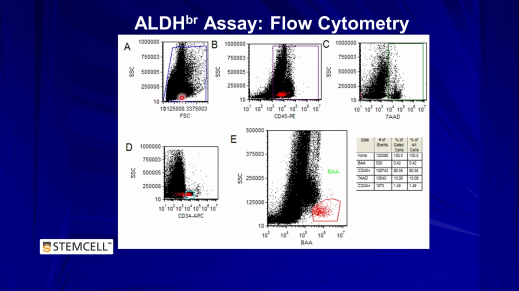Cord Blood Potency Testing
Umbilical cord blood (CB) is a rich source of primitive hematopoietic stem and progenitor cells (HSPCs) for research and transplantation. However, the number of HSPCs in an individual CB unit is often limited by various factors, including unit volume. Cell processing and cryopreservation can also adversely affect the number and quality of viable stem and progenitor cells. For these reasons, it is critical to determine the “potency” of CB units using a cord blood potency assay that measure the number of viable HSPCs.
We have compiled a selection of scientific resources below to help you with CB processing and potency testing.
Development and Validation of a Rapid ALDHbr-Based Cord Blood Potency Assay
Join Dr. Kevin Shoulars, from Duke University Medical Center, as he discusses his work with Dr. Joanne Kurtzberg on the development of a rapid flow cytometry-based method for measuring the potency of cord blood units.
View Now >-
 Maintaining Humidity in CFU Assays using MethoCult‚Ñ¢ MediaTechnical tip from our dedicated team of Product and Scientific Support specialists
Maintaining Humidity in CFU Assays using MethoCult‚Ñ¢ MediaTechnical tip from our dedicated team of Product and Scientific Support specialists -
 Setting Up Controls and Gating for ALDHbr Assay AnalysisFind everything you need to know about preparing the proper single color controls, FMOs and gates for performing flow cytometry analysis of the ALDHbr assay
Setting Up Controls and Gating for ALDHbr Assay AnalysisFind everything you need to know about preparing the proper single color controls, FMOs and gates for performing flow cytometry analysis of the ALDHbr assay -
 Extending the Life of a CFU AssayTechnical tip from our dedicated team of Product and Scientific Support specialists
Extending the Life of a CFU AssayTechnical tip from our dedicated team of Product and Scientific Support specialists -
 Frequently Asked Questions on Primary CellsTechnical tip from our dedicated team of Product and Scientific Support specialists
Frequently Asked Questions on Primary CellsTechnical tip from our dedicated team of Product and Scientific Support specialists -
 CFU Assay Instructions for Global Proficiency Testing ProgramsLearn to perform the colony-forming unit (CFU) assay for Proficiency Testing programs
CFU Assay Instructions for Global Proficiency Testing ProgramsLearn to perform the colony-forming unit (CFU) assay for Proficiency Testing programs -
 STEMvision‚Ñ¢ Automated and Standardized CFC EnumerationFeatures and benefits of the STEMvision‚Ñ¢ system, the world's first automated instrument and computer system for imaging and scoring hematopoietic colonies in the colony-forming cell (CFC) assay
STEMvision‚Ñ¢ Automated and Standardized CFC EnumerationFeatures and benefits of the STEMvision‚Ñ¢ system, the world's first automated instrument and computer system for imaging and scoring hematopoietic colonies in the colony-forming cell (CFC) assay -
 Hematopoietic Colony Enumeration and Identification: A Brief OverviewOverview of the different classes of hematopoietic progenitors detected in colony-forming unit (CFU) assays using various formulations of MethoCult‚Ñ¢ methylcellulose-based media
Hematopoietic Colony Enumeration and Identification: A Brief OverviewOverview of the different classes of hematopoietic progenitors detected in colony-forming unit (CFU) assays using various formulations of MethoCult‚Ñ¢ methylcellulose-based media






